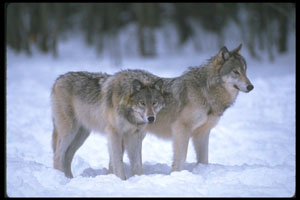

![]()
![]()
![]()
![]()
![]()
![]()
![]()
![]()
![]()
![]()
Hunting Strategies
Wolves are extraordinary predators that play an extremely important part in a healthy, thriving ecosystem. Wolves are called apex predators, which means that they are at the top of the food chain. As predators, they serve to help keep the ecosystem in balance by hunting primarily on prey that is weak, sick or elderly, leaving stronger and healthier animals to survive and produce viable young. Other competing predators would be cougar, coyote, bear and humans.

A predator's life is not an easy one. Almost every time they are hungry, wolves must find and bring down prey. Each predator has its own tools and hunting strategies. Wolves use their incredible sense of smell combined with excellent hearing abilities to help them find vulnerable prey.
Wolves look for the animals they can kill easily, expending as little energy as possible and decreasing chances of injury. Large ungulates like deer, moose, elk and caribou are a wolf's primary food source. Wolves will also eat smaller animals like beaver, rabbit, mice and ground squirrel.
When hunting large game, the wolf pack separates out and surrounds its prey. Wolves usually bite the shoulders and flanks. While some pack members harry the prey from the rear, other wolves seize the prey by the nose.

Hunting can be dangerous for a wolf. The antlers and the hooves of a large animal like a moose or a caribou can injure or kill an attacking wolf. As hunters, wolves have a low success rate. One study shows that for every twelve moose tracked, only one was caught.
Wolves are built for a feast or famine diet and can "wolf" down up to 20 pounds at one feeding. If wolves do not finish what they have killed, the leftovers will feed the scavengers - fox, coyote and raven.
Wolves must travel many miles in order to find suitable prey. Scientists have estimated that one wolf needs ten square miles for a "home" territory. In the Arctic, wolves often follow their main prey, caribou, as the caribou migrate, often thousands of miles.

Pack Hunt
Packs are not formed only to raise puppies; a
great advantage of living in a pack is in finding and killing food. In general,
wolves attack only animals which are young, old, sick, or otherwise weak. This
practice actually raises the quality of some other populations by leaving only
healthy individuals to go on to breed.
![]()
Wolves tend to eat large hoofed animals such as deer, caribou, and musk oxen.
These animals can weigh as much as five or ten times the weight of a single
wolf. The only way a wolf can kill such a large animal is to cooperate with
other pack members; this cooperation allows the pack to chase and kill animals
as large as a moose.
Packs also allow wolves to protect their food once they have made a kill. In many areas, other predators such as bears may try to steal the carcass from the wolves. By hunting in large numbers, some wolves can eat while others chase away potential thieves.
Introduction
[ What is A Wolf ? ] [ Myth And Legend of The Wolf ] [ Physiology of The Wolf ] [ Communication And Behavior of The Wolf ]
[ Family and Social Structure of The Wolf ] [ Hunting And Selection of Prey ] [ The Wolf Today ]
Poems
[ The Lone She-Wolf ] [ Fight of The Midnight Wolf ] [ The Spirit of The Wolf ] [ The Spirituality of Silent Wolf ]
[ The Lady of The Wolves ] [ The Wolf ]
Miscellaneous
[ Did You Know ? ] [ The Language of Wolves ] [ Wolves - Worldwide ] [ Questions And Answers About Wolves ]
Guest Book
[ Special Dedication ] [ Sign My Guest Book / Feedback ] [ View My Guest Book ] [ e-mail Me ]
Best view in IE5. Pentium II. True color (24 bits). Resolution 640 x 480